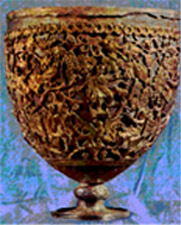
The Chalice of Antioch
Click for high-quality image
The Antioch Chalice
is an important piece of early Christian artwork. Arab workers discovered
it in 1910 and many people originally speculated that it might be the Holy
Grail. The Chalice holds two and a half quarts of liquid, which was the
amount of liquid in Passover cups of that era. Now the Chalice is thought
to have been a tool for receiving the Eucharist but not the Holy Grail.
Eisen dates the Chalice to the first century AD and as proof he writes:
The Great Chalice of Antioch is identical in type with the known chalices of the first century of the Roman Empire with their ovoid truncated bowls, their very short stems, their low and exceedingly narrow feet, formed from a horizontal solid disk often turned on a lathe. Their proportions were not developed free hand, but by a minutely worked out geometric system which determined exactly the outline as well as the height and width of the parts.
Eventually the Chalice was covered with a white gold leaf to help protect
it over the years. Later on, the Chalice was coated with a second layer
of red gold leaf. Eisen dates the Chalice to the first century AD. Every
other work I have consulted dates the Chalice to the first half of the sixth
century AD. Perhaps the original Chalice was constructed in the first century
and the second gold leaf was applied in the sixth century as Eisen thinks.
An alternate theory is presented in the Metropolitan Museum of Art's website:
"Most recently its shape has been recognized as more closely resembling
sixth-century standing lamps, its decoration possibly in recognition of
Christ's words "I am the light of the world" (John 8:12)."
The Chalice has a picture of Christ in his prime on its front and a picture
of Christ in his youth on its back. There are also ten other figures on
the Chalice who have their right hands raised to salute Christ. This same
sort of salute was used by Romans to salute the Emperor in Christ's time.
Eisen identified the other ten figures as Saint James the Lesser, Saint
Peter, Saint Paul, Saint Jude, Saint Andrew, Saint Luke, Saint Mark, Saint
Matthew, Saint John, and Saint James the Greater. Eisen identifies the two
pictures of Christ and the pictures of the saints in unique ways. For example,
according to Hegesippus, Saint James only wore linen.
On the Chalice, his garment falls in thin pliable folds, such as only linen
produces, while the dress of all the others shows heavy folds like those
produced by wool. The thin texture of the garment permits the outlines of
the body to be seen underneath, and gives that apparent elegance of body
which is otherwise found only in Saint John.
The Antioch Chalice probably is not the Holy Grail as many people originally
thought. It is however extremely useful in showing us what sort of Chalice
was used to give the Eucharist by the early church in Antioch. In addition
the Chalice shows us that early Christians viewed Jesus as being clean-shaven
with sort hair in opposition to the bearded longhaired image of Jesus that
many of us hold.
Details of the Chalice
Gustavus A. Eisen, The Great Chalice of Antioch (New York:
New York and Madison Square Press, 1933)
Metropolitan Museum of Art (http://www.metmuseum.org/collections/view1.asp?dep=7&full=0&item=50%2E4)
Archaeology